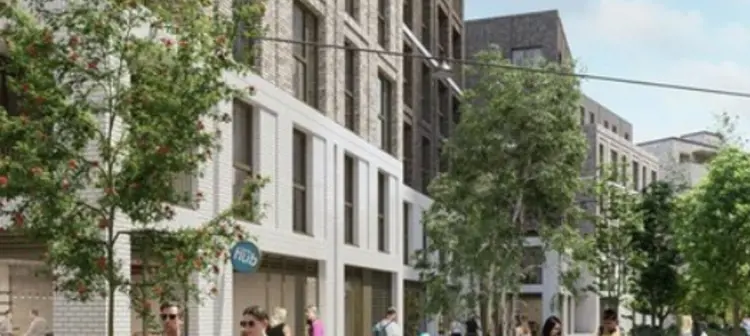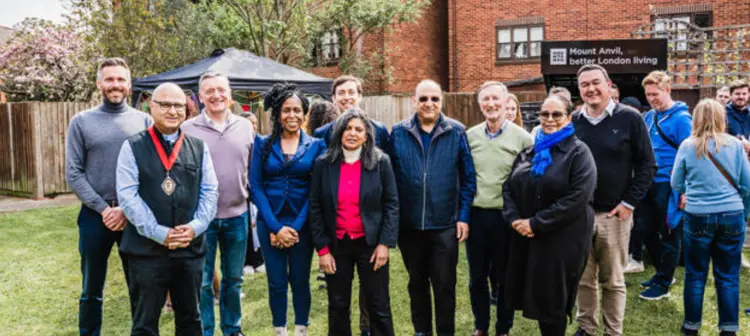Why redevelop Friary Park?
Many residents of Friary Park are unhappy with several important aspects of their homes. The main causes of residents’ dissatisfaction with their homes are poor design, size and layouts, poor energy efficiency, and the layout of the estate overall.
These things cannot be dealt with by maintenance or refurbishment. Improvements to the local transport infrastructure offer us the opportunity to redevelop Friary Park to provide high-quality affordable homes by building additional homes for sale.
When was Friary Park developed?
Laing Homes originally built Friary Park for private sale in the late 80s. It was purchased by Catalyst (then Ealing Family Housing Association) in 1988.
What are the development plans?
We’ll completely redevelop the estate and build a mixed-tenure neighbourhood of new high-quality homes. We’ll provide social rented housing and affordable rented homes on the estate, as well as new homes for shared ownership and market sale.
We’re building 1,228 new homes in buildings between three and 24 storeys. We’re also building shops and community spaces at ground floor level and creating green open space.
The regeneration will dramatically improve housing conditions with more family-sized at affordable rent to meet what current residents need.
How have residents been involved so far?
Since November 2014, we’ve carried out extensive consultation with residents of Friary Park and the surrounding area.
This has included working closely with the Friary Park Residents Steering Group (RSG). The RSG was formed to represent the different views of residents living on the estate throughout the regeneration.
We meet regularly with the RSG and have also held workshops and exhibitions for all residents and local stakeholders to get their input on our proposals. We’ve made the sessions as inclusive as possible with dedicated meetings for older people, young adults, mothers with young children and residents whose first language is not English.
Although the initial planning application has been granted, there’ll be lots more for the local community to help to shape.
Covid has changed how and where many of us work and spend our time, and in turn, what residents need and expect from their homes and the local area. We’ve taken this into account and made changes to some of the plans for Friary Park. These include more communal green spaces, creating a community square as the main hub for activities, a community kitchen and edible garden and increasing the size of balconies.
We’ll be consulting with residents on specific aspects of the scheme such as play space, sustainability and community centre, and on the detailed design of Phase 3, for which we already have outline planning permission.
What will the space standards be like in the new homes?
The new homes will be bigger than the current homes at Friary Park. All affordable homes will meet the London Housing Design Guide which sets out minimum sizes for rooms.
Will the increase in the number of homes mean less green space?
Our proposals include delivering more open space than is currently on the estate. This will contain semi-private green spaces for each set of buildings, a green pedestrian-friendly street with play areas and a new multi-use games area opposite the existing Friary Green. Friary Green does not count towards the quota of open space in the proposals and will not be built on.
All new homes will have a private outdoor space (garden, balcony or terrace) and access to semi-private green spaces.
How high is the tallest part of the proposed development?
The buildings in the plans range from three to 24 storeys. The buildings backing onto Emanuel Avenue will be the lowest, with the height of buildings being stepped up from here with the tallest opposite the railway and the station.
The four tallest buildings are 24, 22 (two buildings) and 18 storeys.
Building tall buildings means we can provide the number and type of homes needed for current residents and also help fund the regeneration by building homes for sale. It also means we can maximise the green space in Friary Park.
The three tallest buildings are separated and the middle is one stepped back. This design means light can still get through to the buildings behind and that the approach to the estate feels open and welcoming.
What happens to the current residents of Friary Park?
All existing Peabody residents on Friary Park will have the option of a new home on the new development if they’d like one. Most residents will be able to move straight into a brand-new home, however, to allow the existing buildings to be demolished so that new homes can be built, some residents in the first phase were asked to move away from Friary Park. This move off Friary Park will either be a temporary one until a suitable new home is available in a later phase, or a permanent one if they no longer wish to live n Friary Park.
Any tenants of Ealing Council who have a temporary tenancy on Friary Park will be rehoused by the council. Anyone renting a home on Friary Park through a housing co-operative will need to work with their co-operative to find a new home. Peabody will provide sufficient notice to all residents in advance of their anticipated moves.
What are the timescale for the regeneration?
In February 2023, we took handover of 113 new homes to Friary Park residents. Our next handover will take place in Spring 2024 and will include a mixture of affordable homes and homes for market sale.
Homes in Phase 2 will be ready for people to move into in 2025. and Phase 3 in 2027.
This is a big project. How will the new homes be built?
We’ll be redeveloping Friary Park in three phases. Building the new homes in phases means we can maximise the number of current residents who’ll be able to move straight from their current home into a new home.
How are you managing potential disruption from construction traffic?
Mount Anvil is our partner building contractor on this project and as part of the planning process, they submit a detailed Construction Traffic Management Plan to Ealing Council. This plan is tailored for each phase of construction and includes details of how construction traffic will move around the site, how disruption will be minimised and what health and safety measures will be in place.
What will you do to minimise noise and vibrations during construction?
We understand demolition and construction can be inconvenient, we will do everything we can to ensure residents and neighbours can live comfortably while the work is carried out.
Construction hours are Monday to Friday 8am–6pm and on Saturdays 8am–1pm. Occasionally we may need to extend these working hours due to deliveries and the ongoing national shortage of HGV.
If you have any queries, please call our contact centre on 0300 1233456.
Keeping in touch
Look out for our quarterly newsletters for updates on all regeneration related activities at Friary Park including opportunities for residents and ways to get involved. You’ll also find updates on the community noticeboards.

About the regeneration project

